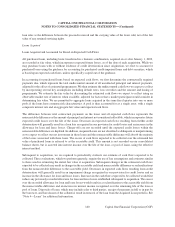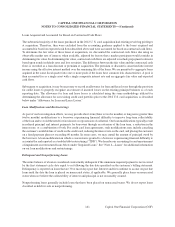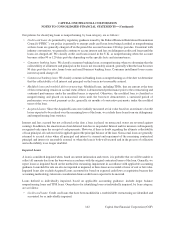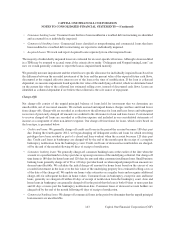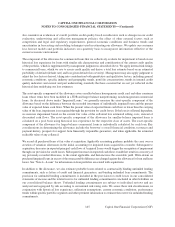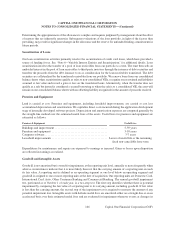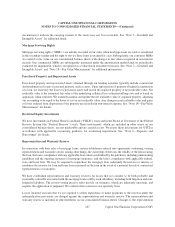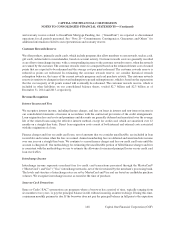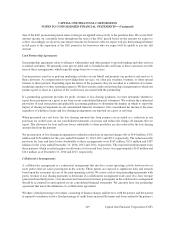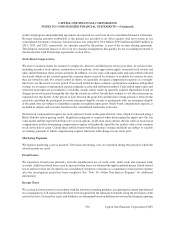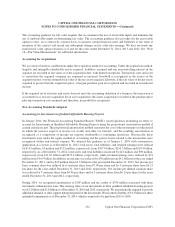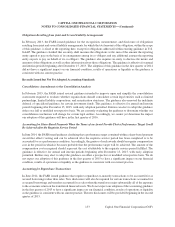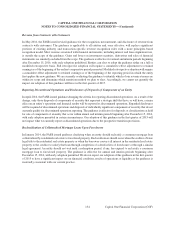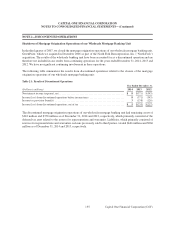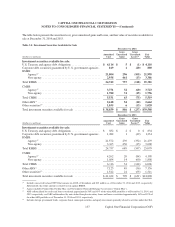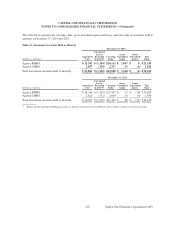Capital One 2014 Annual Report Download - page 171
Download and view the complete annual report
Please find page 171 of the 2014 Capital One annual report below. You can navigate through the pages in the report by either clicking on the pages listed below, or by using the keyword search tool below to find specific information within the annual report.149
date of the SAC promotional period, interest charges are applied retroactively to the purchase date. We accrue SAC
interest income on a monthly basis throughout the term of the SAC period based on the amount we expect to
collect. Accordingly, we do not accrue interest income for borrowers who we expect will pay their principal balance
in full prior to the expiration of the SAC period or for borrowers who we expect will be unable to pay the full
amount.
Card Partnership Agreements
Our partnership agreements relate to alliances with retailers and other partners to provide lending and other services
to mutual customers. We primarily issue private-label and co-branded credit card loans to these customers over the
term of these arrangements, which typically range from two to ten years.
Certain partners assist in or perform marketing activities on our behalf and promote our products and services to
their customers. As compensation for providing these services, we often pay royalties, bounties, or other special
bonuses to these partners. Depending upon the nature of the payments, they are recorded as a reduction of revenue,
marketing expenses or other operating expenses. We have certain credit card partnership arrangements in which our
partner agrees to share in a portion of the credit losses associated with the partnership.
If a partnership agreement provides for profit, revenue or loss sharing payments, we must determine whether to
report those payments on a gross or net basis in our consolidated financial statements. We evaluate the contractual
provisions of each transaction and applicable accounting guidance to determine the manner in which to report the
impact of sharing arrangements in our consolidated financial statements. Our consolidated net income is the same
regardless of whether revenue and loss sharing arrangements are reported on a gross or net basis.
When presented on a net basis, the loss sharing amounts due from partners are recorded as a reduction in our
provision for credit losses on our consolidated statements of income and reduce the charge-off amounts that we
report. The allowance for loan and lease losses attributable to these portfolios are also reduced by the loss sharing
amount due from the partners.
Net presentation of loss sharing arrangements resulted in reductions in reported charge-offs of $164 million, $151
million and $156 million for the years ended December 31, 2014, 2013 and 2012, respectively. The reduction in the
provision for loan and lease losses attributable to these arrangements were $167 million, $111 million and $187
million for the years ended December 31, 2014, 2013 and 2012, respectively. The expected reimbursement from
these partners, which is netted against our allowance for loan and lease losses, was approximately $143 million and
$141 million as of December 31, 2014 and 2013, respectively.
Collaborative Arrangements
A collaborative arrangement is a contractual arrangement that involves a joint operating activity between two or
more parties that are active participants in the activity. These parties are exposed to significant risks and rewards
based upon the economic success of the joint operating activity. We assess each of our partnership agreements with
profit, revenue or loss sharing payments to determine if a collaborative arrangement exists and, if so, how revenue
generated from third parties, costs incurred and transactions between participants in the collaborative arrangement
should be accounted for and reported on our consolidated financial statements. We currently have one partnership
agreement that meets the definition of a collaborative agreement.
We share a fixed percentage of revenues, consisting of finance charges and late fees, with the partner, and the partner
is required to reimburse us for a fixed percentage of credit losses incurred. Revenues and losses related to the partner’s
CAPITAL ONE FINANCIAL CORPORATION
NOTES TO CONSOLIDATED FINANCIAL STATEMENTS—(Continued)
Capital One Financial Corporation (COF)



